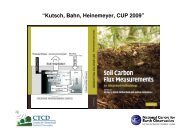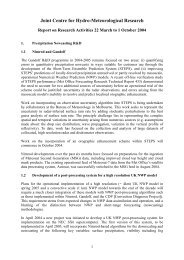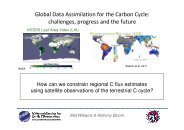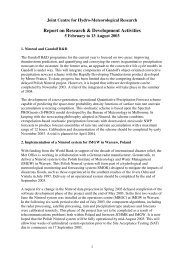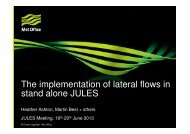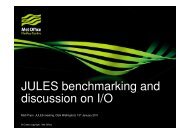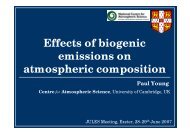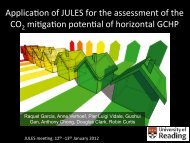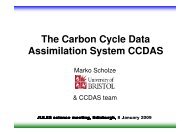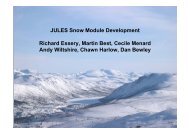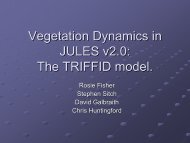Climate change research at the Met Office Hadley Centre - JULES
Climate change research at the Met Office Hadley Centre - JULES
Climate change research at the Met Office Hadley Centre - JULES
- No tags were found...
Create successful ePaper yourself
Turn your PDF publications into a flip-book with our unique Google optimized e-Paper software.
Using <strong>JULES</strong> for impacts assessment tounderpin UK and intern<strong>at</strong>ional clim<strong>at</strong>epolicyRichard Betts<strong>Met</strong> <strong>Office</strong> <strong>Hadley</strong> <strong>Centre</strong>© Crown copyright <strong>Met</strong> <strong>Office</strong>
2 major clim<strong>at</strong>e policy activitiesrequiring robust input from clim<strong>at</strong>escience and rel<strong>at</strong>ed fields• Intern<strong>at</strong>ional: United N<strong>at</strong>ions FrameworkConvention on <strong>Clim<strong>at</strong>e</strong> Change (UNFCCC)• UK: <strong>Clim<strong>at</strong>e</strong> Change Risk Assessment (CCRA)© Crown copyright <strong>Met</strong> <strong>Office</strong>
United N<strong>at</strong>ions FrameworkConvention on <strong>Clim<strong>at</strong>e</strong> Change(UNFCCC)• Primary aim is to “avoid dangerous clim<strong>at</strong>e <strong>change</strong>”• Therefore need to know wh<strong>at</strong> “dangerous clim<strong>at</strong>e<strong>change</strong>” actually is• Emerging issue is facilit<strong>at</strong>ing adapt<strong>at</strong>ion to committedclim<strong>at</strong>e <strong>change</strong> in developing countries• Therefore need to assess clim<strong>at</strong>e risks, hazards andvulnerabilities <strong>at</strong> regional scales, in context of o<strong>the</strong>rstresses• Main source of underpinning science advice to UNFCCCis Intergovernmental Panel on <strong>Clim<strong>at</strong>e</strong> Change (IPCC)• Fifth Assessment Report (AR5) currently being written –due out 2013-2014 (3 phases)© Crown copyright <strong>Met</strong> <strong>Office</strong>
IPCC Working GroupsWG1PhysicalScienceBasis© Crown copyright <strong>Met</strong> <strong>Office</strong>WG2Impacts,Adapt<strong>at</strong>ion &VulnerabilityWG3Mitig<strong>at</strong>ion
AR5 WG2 structure© Crown copyright <strong>Met</strong> <strong>Office</strong>• Context• N<strong>at</strong>ural and Managed Resources andEcosystems, and Their Uses• Human Settlements, Industry, andInfrastructure• Human Health, Well-Being, and Security• Adapt<strong>at</strong>ion and Development• Multi-Sector Impacts, Risks, Vulnerabilities, andOpportunities• Regional aspects
N<strong>at</strong>ural and Managed Resources andEcosystems, and Their Uses3. Freshw<strong>at</strong>er resources4. Terrestrial and freshw<strong>at</strong>er ecosystems- (R Betts one of Lead Authors)5. Coastal ecosystems and low-lying areas6. Ocean ecosystems7. Food systems and food security© Crown copyright <strong>Met</strong> <strong>Office</strong>
Human settlements, industry andinfrastructure8. Urban Areas9. Rural Areas10. Key economic sectors and services© Crown copyright <strong>Met</strong> <strong>Office</strong>
Multi-Sector Impacts, Risks,Vulnerabilities, and Opportunities18. Detection and <strong>at</strong>tribution of observed impacts19. Emergent and key risks and vulnerabilities20. <strong>Clim<strong>at</strong>e</strong>-resilient p<strong>at</strong>hways: adapt<strong>at</strong>ion,mitig<strong>at</strong>ion, and sustainable development© Crown copyright <strong>Met</strong> <strong>Office</strong>
Regional aspects© Crown copyright <strong>Met</strong> <strong>Office</strong>21. Regional context (R Jones one of Lead Authors)22. Africa23. Europe24. Asia25. Australasia26. North America27. Central and South America28. Polar Regions29. Small Islands30. Intern<strong>at</strong>ional W<strong>at</strong>ers
UK <strong>Clim<strong>at</strong>e</strong> Change RiskAssessment: Aims• “To undertake an assessment of <strong>the</strong> risks (including opportunities)from clim<strong>at</strong>e <strong>change</strong> to those things th<strong>at</strong> have social,environmental and economic value in <strong>the</strong> UK, to help <strong>the</strong>Government cre<strong>at</strong>e an enabling environment for <strong>the</strong> UK to adaptand identify priorities for action.”• To fulfil <strong>Clim<strong>at</strong>e</strong> Change Act 2008• To understand current and future risks and opportunities• To inform Government adapt<strong>at</strong>ion actions• To raise awareness of UK clim<strong>at</strong>e risks• To develop capacity – learning process• To identify <strong>research</strong> needs (inform next CCRA – 5 year cycle)• 1 st CCRA reports to Parliament 26 th January 2012© Crown copyright <strong>Met</strong> <strong>Office</strong>
CCRA Sectors and <strong>the</strong>mesSECTORS• Agriculture• Biodiversity & Ecosystem Services• Built Environment• Business, Industry & Services• Energy• Flooding & Coastal Erosion• Forestry• Health• Marine (incl. fisheries)• Transport• W<strong>at</strong>erTHEMES• N<strong>at</strong>ural Environment• Agriculture & Forestry• Business• Buildings & Infrastructure• Health & Well-being© Crown copyright <strong>Met</strong> <strong>Office</strong>
CCRA <strong>Met</strong>hod in Brief1. Choose priority risks 2. Assess sensitivity ofeach risk to current~700risks~100risks clim<strong>at</strong>eMagnitude3. Add projections offuture clim<strong>at</strong>e/ popul<strong>at</strong>ionfor each riskHighMediumLikelihoodUrgencyLow6. Compare scores of allrisks5. Assign magnitude (logarithmicscale) and confidence scores to eachriskMagnitude Low Medium HighSocial 100s 1000s Millions% <strong>change</strong> in DO, Dry scenariounknown-20% to -16%-16% to -12%-12% to -8%-8% to -6%-6% to -4%-4% to -2%-2% to -1%-1% to 0%0% to 1%1% to 2%2% to 4%4% to 6%4. Compare by areafor each risk.Economic £1 M £10 M £100 MEnv. 100km 1000km 10,000km© Crown copyright <strong>Met</strong> <strong>Office</strong>
© Crown copyright <strong>Met</strong> <strong>Office</strong>How can <strong>JULES</strong> contribute to currentIPCC and next CCRA?• Both IPCC and CCRA take a fragmented, sectorfocussedapproach• Often <strong>the</strong> user-focussed impacts work done quickly tocustomer timescales not scientific ones!• Need for a robust, scientifically-proven tool th<strong>at</strong> can beeasily and rapidly applied• Individual sectors (food, w<strong>at</strong>er, energy, etc) generallyexamined independently of each o<strong>the</strong>r (so inconsistent)• Real world more integr<strong>at</strong>ed• Physical interdependencies• Socio-economic interdependencies• As a process-based model of terrestrial systems, <strong>JULES</strong>can be a framework for accounting for physicalinterdependencies• Very little work done on detection and <strong>at</strong>tribution ofimpacts
© Crown copyright <strong>Met</strong> <strong>Office</strong>Integr<strong>at</strong>ed land impacts modelling
© Crown copyright <strong>Met</strong> <strong>Office</strong>CO 2 rise, clim<strong>at</strong>e <strong>change</strong> and <strong>the</strong>hydrological cycle
Impacts of <strong>change</strong>s in popul<strong>at</strong>ion,clim<strong>at</strong>e and CO 2 on w<strong>at</strong>er stressRAD: CO 2 only acts as agreenhouse gasRADPHYS: CO 2 alsoaffects plant physiology© Crown copyright <strong>Met</strong> <strong>Office</strong>
Different predictionsusing hydrology modelsinside and outside ofclim<strong>at</strong>e modelsRiver runoff <strong>change</strong>ssimul<strong>at</strong>ed by a hydrologymodel separ<strong>at</strong>e from clim<strong>at</strong>emodelsNo. of models giving increased runoffRiver runoff <strong>change</strong>s directlysimul<strong>at</strong>ed within clim<strong>at</strong>emodels(Number of models simul<strong>at</strong>ingincreased runoff <strong>at</strong> 4 C warming)No. of models giving increased runoff© Crown copyright <strong>Met</strong> <strong>Office</strong>
Proposed work for Fifth AssessmentReport (AR5) with <strong>JULES</strong>: improvedimpacts projections• Global-scale projections of biophysical impactsth<strong>at</strong> are internally-consistent:• Runoff• Groundw<strong>at</strong>er recharge?• Terrestrial ecosystems• Crop productivity• Include linkages via large-scale hydrology:• Irrig<strong>at</strong>ion• River flows© Crown copyright <strong>Met</strong> <strong>Office</strong>
Proposed work for AR5 with <strong>JULES</strong>:improved <strong>at</strong>tribution• Global-scale simul<strong>at</strong>ions of past biophysicalimpacts th<strong>at</strong> are internally-consistent:• Runoff, river flows• Terrestrial ecosystems• Include more complete tre<strong>at</strong>ment of direct andindirect clim<strong>at</strong>e processes:• Local precipit<strong>at</strong>ion + evapor<strong>at</strong>ion• Remote influences via rivers• Indirect effects eg: veget<strong>at</strong>ion impacts on hydrology• O<strong>the</strong>r anthropogenic drivers eg: land use, irrig<strong>at</strong>ion© Crown copyright <strong>Met</strong> <strong>Office</strong>
Priorities for delivering impacts toAR5• Provide more integr<strong>at</strong>ion between processes th<strong>at</strong> havepreviously been assessed in AR4• More complete represent<strong>at</strong>ion of land hydrology• Inclusion of crops• Simul<strong>at</strong>ion of existing processes not compromised• Fully oper<strong>at</strong>ional on global grid:• Science works (and is credible!) everywhere in world• Driving d<strong>at</strong>a / ancillary files available on global grid• Valid<strong>at</strong>ed on global grid• Deliver in time to be assessed in <strong>the</strong> report!© Crown copyright <strong>Met</strong> <strong>Office</strong>
O<strong>the</strong>r priorities• Remember <strong>JULES</strong> also intended as landsurface scheme for Unified Model – bothclim<strong>at</strong>e and we<strong>at</strong>her forecast configur<strong>at</strong>ions• <strong>JULES</strong> developments which reduceperformance of <strong>at</strong>mosphere model will not beused in oper<strong>at</strong>ional <strong>Met</strong> <strong>Office</strong> configur<strong>at</strong>ions ofUM! (both clim<strong>at</strong>e and we<strong>at</strong>her configur<strong>at</strong>ions)• Limit divergence from UM version of <strong>JULES</strong> asfar as possible – easier to test and maintain© Crown copyright <strong>Met</strong> <strong>Office</strong>
Timescales for inclusion in AR5Working Group 2 report (Impacts,Adapt<strong>at</strong>ion and Vulnerability)• Zeroth Order Draft (ZOD) underwent informal review Autumn 2011• Several members of <strong>JULES</strong> community took part in informal review –thank you, very useful indeed!• First Order Draft (FOD) currently being written.• Lead authors need to be familiar with current work NOW• FOD out to formal review June 2012• Please consider volunteering to be expert reviewer• Second Order Draft (SOD) to be written early 2013• Cited papers need to be submitted by 31 st January 2013• Final draft l<strong>at</strong>e 2013• Cited papers need to accepted by 31 st August 2013• Report public<strong>at</strong>ion April 2014© Crown copyright <strong>Met</strong> <strong>Office</strong>



